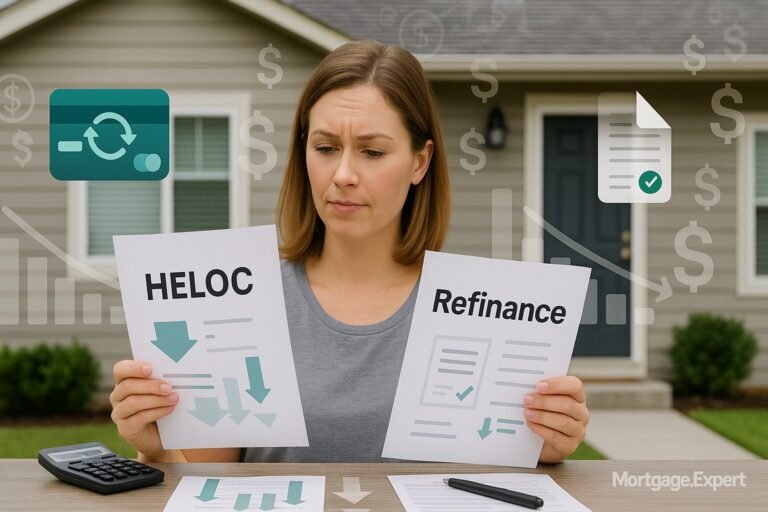
How to Escape Negative Amortization on Your Mortgage in Canada
If you’ve recently checked your mortgage statement and noticed your balance is growing instead of shrinking, don’t panic—but don’t ignore it either. What you’re experiencing might be negative amortization, and while it can sound complicated (or scary), there are clear steps you can take to fix it.
In this guide, we’ll break down what negative amortization actually is, how it happens (especially with variable-rate mortgages), and most importantly, what you can do right now to get out of it. Whether you’re a first-time buyer or several years into your mortgage term, understanding and addressing this issue is essential to avoid long-term financial stress.
What Is Negative Amortization?
Let’s start simple: your mortgage is supposed to go down over time, not up. That’s what amortization means—gradually paying down your loan through regular payments, with a portion going toward interest and the rest toward principal.
But in some cases, your monthly payment might not even be enough to cover the interest. When that happens, the unpaid interest gets added to your original loan amount, and your balance increases. That’s called negative amortization—or what lenders sometimes refer to as over-amortization.
This issue is most common with variable-rate mortgages (VRMs) and interest-only payment plans. And it’s become more frequent in Canada over the past few years thanks to rapid interest rate hikes from the Bank of Canada.
Imagine it like this: you’re trying to dig yourself out of a hole, but instead of getting higher ground, the hole keeps getting deeper every month—even as you shovel.
How Does Negative Amortization Happen in Canada?
There are two main paths to negative amortization for Canadian homeowners:
1. Variable-Rate Mortgages (VRMs)
These mortgages come with a fixed payment schedule, even though the interest rate itself is floating. That means your payment amount doesn’t automatically adjust when the prime rate goes up.
When rates rise sharply, your fixed monthly payment might no longer cover the growing interest charges. At this point, you hit what’s known as your trigger rate—the point where every cent you pay goes toward interest, and your principal isn’t touched at all. Keep going, and you eventually hit the trigger point, where even your full payment isn’t enough to cover the interest. That’s when the balance starts ballooning.
For insured mortgages, lenders may allow up to 105% loan-to-value (LTV) before stepping in. For uninsured mortgages, that cap is usually around 80% LTV.
2. Interest-Only Mortgages
This structure allows you to pay only the interest for a set period, often the first few years of the loan. The catch? You’re not chipping away at your principal at all. Once the interest-only period ends, your payments jump up significantly, and if rates rise or you’re not ready, the loan can quickly spiral into negative amortization territory.
Why It’s Important to Act Quickly
When you’re stuck in negative amortization, every month your balance grows. That means you’ll pay more interest over the life of the loan, your equity shrinks, and if you ever sell, you may owe more than your home is worth.
In worst-case scenarios, lenders can demand corrective action—like higher monthly payments, a lump sum, or refinancing. And that’s not always affordable if you’re already feeling squeezed.
The good news? There are solutions. And the sooner you act, the more options you’ll have.
5 Practical Ways to Get Out of Negative Amortization
1. Increase Your Mortgage Payments
This might seem obvious, but it’s also one of the most effective. The more you pay each month, the more likely you are to cover the full interest portion—and start reducing your principal again.
If you’re in a variable-rate mortgage, contact your lender and ask to adjust your payment amount to reflect current rates. Many lenders allow you to increase payments or make extra contributions without penalty (up to a certain annual limit).
Another tactic? Make lump-sum payments if you have savings or receive a bonus. Even a few thousand dollars can significantly reduce your balance and get you back on track.
📉 Interest vs Principal Over Time
Your mortgage payments shift over time — here’s how they move from interest-heavy to principal-focused.
📌 Based on a 25-year fixed mortgage at 5% interest.
2. Switch to a Fixed-Rate Mortgage
If you’re tired of living with the uncertainty of rising rates, converting your mortgage to a fixed rate might make sense. This won’t erase your existing negative amortization, but it stops it from getting worse—you lock in a predictable monthly amount, usually higher than your current VRM payment, but guaranteed to cover both interest and principal.
Speak with your lender to understand the conversion process. Some lenders allow you to switch mid-term without penalty if you’re staying with the same institution. Make sure you understand the long-term impact of switching, especially if you plan to sell or refinance in the next few years.
If your VRM has already hit the trigger point, you might also want to ask your lender about switching to an adjustable-rate mortgage (ARM) instead, which auto-adjusts payments to keep pace with interest—eliminating the risk of future negative amortization.
3. Refinance Into a New Mortgage
Refinancing essentially means replacing your current mortgage with a new one—ideally one with better terms or a longer amortization period.
In a rising-rate environment, refinancing might not save you money right away, but it can help you reset your amortization schedule, extend your payment term, and eliminate over-amortization.
Before refinancing, do your homework:
- Check your credit score and improve it if needed.
- Shop around for competitive rates.
- Use a mortgage calculator to compare different scenarios and monthly savings.
- Ask about fees, penalties, and legal costs involved in refinancing.
Sometimes refinancing also gives you access to home equity through a HELOC or second mortgage—but weigh those options carefully, especially if your current home value has dropped.
📌 Should You Refinance Your Mortgage? – Pros & Cons in Canada
Refinancing your mortgage can save you money — or cost you more than you expect. Here’s a quick breakdown of the benefits and risks Canadian homeowners should know before making a move.
Locking in a better rate can reduce your monthly payments and total interest.
Refinance to tap into built-up equity for renovations, debt consolidation, or big expenses.
You can choose a shorter term to become mortgage-free faster, or extend to lower payments.
Breaking your current mortgage can trigger hefty fees, especially with fixed rates.
Refinancing often resets your mortgage clock, meaning more interest in the long run.
You’ll pay for a new property appraisal, legal fees, and potentially other closing costs.
📝 Tip: Always calculate the break-even point and compare lenders before refinancing. Not every offer is a win.
4. Renegotiate Your Mortgage Terms
If refinancing isn’t possible, you may still be able to modify the terms of your existing mortgage. Many lenders are open to adjusting amortization periods or switching products if it helps reduce the risk of default.
For example, if your current amortization is 20 years, asking for a 25- or 30-year reset could spread out your payments and give you breathing room. While this means you’ll pay more in interest over time, it can eliminate the immediate problem of negative amortization.
Speak with your lender directly and ask about options. If needed, bring in an independent mortgage broker to advocate on your behalf. A third-party expert can often negotiate terms that suit you better—without being tied to one lender’s products.
5. Get Expert Advice From a Mortgage Specialist
If you’re unsure where to start, you’re not alone—and you don’t have to figure it out all by yourself.
A mortgage broker or financial planner can:
- Review your current mortgage and financial situation
- Help you understand your trigger rate and trigger point
- Compare your refinancing or conversion options
- Explore government programs that may apply to your situation
- Negotiate on your behalf to get better terms
They can even refer you to legal professionals if your mortgage is at risk of default or if you’re considering selling.
This kind of support is especially important if you’re juggling other debts, like car loans or student loans, or if your income has recently changed due to job loss or family expansion.
Frequently Asked Questions About Negative Amortization in Canada
What should I do if my mortgage balance is increasing?
First, contact your lender to confirm if you’ve hit your trigger point. Then explore increasing payments, refinancing, or switching to a fixed-rate mortgage.
Is negative amortization legal in Canada?
Yes, but lenders must disclose the risks. Many VRMs have terms that allow negative amortization, but once you pass a certain LTV threshold (usually 105%), corrective action is required.
How do I know if I’ve hit my trigger rate?
Your lender should notify you when this happens. You can also calculate it by reviewing your mortgage documents and seeing when your payment no longer covers the full interest.
Can I switch to a fixed-rate mortgage mid-term?
Yes, in many cases. But there may be fees or penalties depending on your lender. Always ask before committing.
Will my credit score be impacted by negative amortization?
Not directly. But if it leads to missed payments, delinquency, or default, your credit can be affected. That’s why early action is key.
Final Thoughts: Take Control Before It Spirals
Negative amortization might sound like a technical mortgage term, but its effects are very real—and potentially very costly. The good news is, you can fix it, especially if you act quickly.
Whether you choose to increase payments, refinance, change your mortgage terms, or get expert help, there are multiple pathways back to healthy homeownership.
You worked hard to buy your home. Don’t let market changes erase your progress. With a smart plan and a little support, you can get back on track—and even use this as a learning opportunity to strengthen your long-term financial future.
Don’t Let Negative Amortization Drain Your Equity
If your mortgage balance is growing instead of shrinking, it’s time to act. Talk to a Canadian mortgage expert who can help you adjust your payments, refinance, or switch to a better-suited product.
Fix My Mortgage Now
Stuck with a Mortgage Decision?
Don’t stress — our team is here to help. Reach out for free, no-obligation guidance.
Contact the Experts



